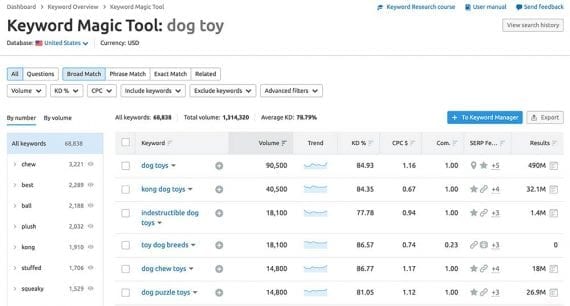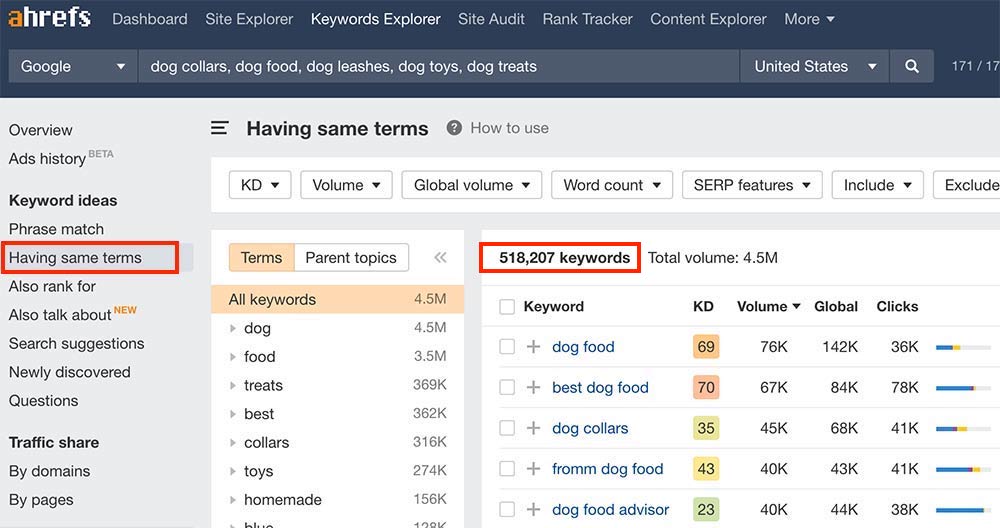Content on an ecommerce site’s product detail pages, category pages, and blog can attract visitors and lead to sales and profit.
For many commerce businesses — omnichannel retailers, ecommerce-only merchants, and wholesalers — attracting a steady flow of site visitors from organic search results is vital for success. But achieving high rankings in those results requires optimizing a site with relevant content.
SEO and Content Marketing
Search engine optimization is the process of organizing a website to communicate its purpose and value to Google, Bing, and similar. The result, hopefully, is highly-ranked pages in search results, producing more and better visitors.
Content marketing is the act of creating, publishing, and promoting content to attract, engage, and retain customers. The goal of content marketing and SEO is the same: generate visitors.
For this article, I’m going to put SEO first in the process.
Content marketers will sometimes create articles or videos that are not directly related to the products their business sells but instead around topics that interest prospects.
For example, an online shop that sells 4×4 truck accessories might produce content about backcountry hiking. Why? Because folks who hike in the backcountry likely drive four-wheel-drive vehicles. The hikers might need a vehicle accessory or two.
Consider the “Michelin Guide” series. Michelin, which sells tires, started publishing a series of hotel and restaurant guides about 120 years ago. Folks who stay at hotels and eat at restaurants presumably drive there in an automobile. Eventually those folks will need tires.
Neither of these examples is product-centric. Product content marketing starts with the item to be sold. It is about 4×4 accessories or tires, not about hiking and the best restaurant. Product-centric content marketing requires keyword research.
Seeds
As with any form of SEO keyword research, start with seed words. For an ecommerce business, these keywords might be the names of its product categories.
For example, if it went looking for seed keywords, a pet-supplies store might pick “dog food,” “dog treats,” “dog toys,” “dog leashes,” “dog collars,” and similar. These are the product category names for Menards, which sells pet goods in addition to home improvement items.
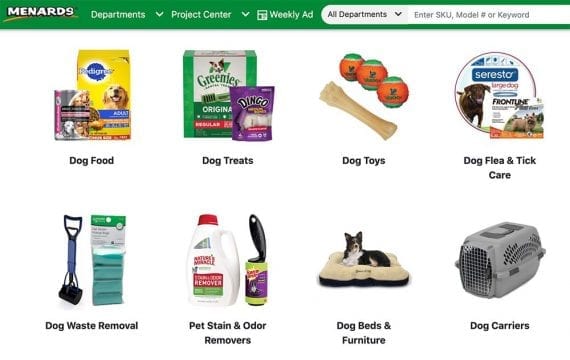
If it were doing product content marketing for pet supplies, Menards might start with category names as keywords.
In the same way, an online retailer selling shoes might select seed keywords such as “sneakers,” “loafers,” “boots,” and even “tuxedo shoes” for its product content marketing. Those are the category names for Suitsupply.
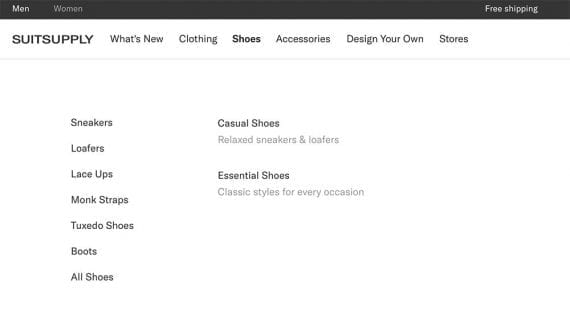
Suitsupply’s category names for shoes are potential keywords for optimizing organic search.
Keyword Ideas
Using the list of seeds, start to generate other keyword ideas. Look for the phrases shoppers use when searching for your products or services. Many tools can help. For example, Google’s auto-suggest feature shows popular and relevant keyword phrases.
If you enter the phrase “dog toy” in Google search, auto-suggest shows keyword phrases such as:
- “Dog toys for big dogs,”
- “Dog toys for chewers,”
- “Dog toys for small dogs,”
- “Dog toys made in USA,”
- “Dog toys with toys inside.”
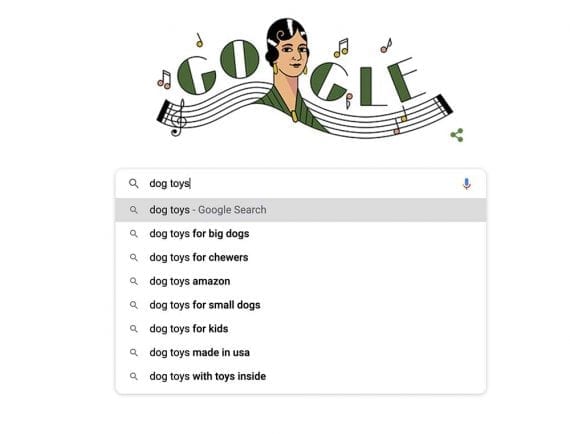
Google’s auto-suggest can produce useful keywords, such as this example for the search query “dog toys.”
You can find more keywords when you search for one of the suggested phrases. For example, “Dog toys for big dogs” leads you to “large dog toys aggressive chewers.”
Ahrefs Keywords Explorer is another good option for generating search-engine keyword ideas. Explorer can accept one or several keyword seeds at a time. It can also find keywords for YouTube.
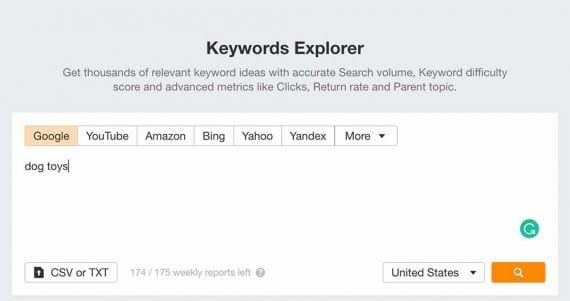
Ahrefs Keywords Explorer can accept one or several keyword seeds at a time. It is also helpful for finding keywords for YouTube.
Add a term or even several terms to Keywords Explorer. In the ensuing results, look for the “having same terms” link in the left menu. That report will be a list of thousands of keyword ideas. And for each of these ideas, you can keep digging deeper.
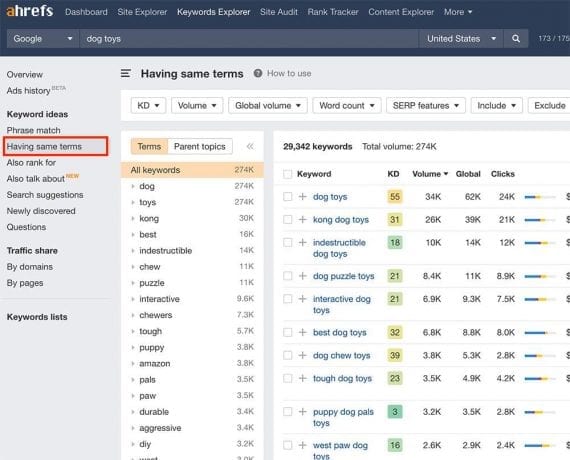
The “having same terms” reports in Ahrefs is helpful for generating keyword ideas based on your seed phrases.
Finally, SEMrush’s Keyword Magic Tool is also an excellent way to generate keyword ideas based on product-centric seed phrases.
Sorting Keywords
The next step in product-specific research is to sort the keywords.
If you used a manual process such as Google’s auto-suggest, build a spreadsheet and then capture more info about the keyword phrase using Ahrefs, SEMrush, Google Ads Keywords Planner, or similar. Essential details include:
- Monthly search volume,
- Keyword difficulty,
- Parent topic.
Consider also:
- Average PPC cost,
- Competitive density,
- Your company’s current rank.
Then use Ahrefs, SEMrush, or similar to sort, such as for these keyword phrases:
- dog food,
- dog treats,
- dog toys,
- dog leashes,
- dog collars.
We could enter all of these into the Ahrefs Keywords Explorer and look for the ideas under the “having same terms” report. There are more than half a million keyword phrase ideas there.
You could sort by the search volume and look for phrases with more than 250 monthly searches. You might also filter for terms that are relatively easier to rank for, those with a maximum keyword difficulty of 20.
Applying both filters in Ahrefs — search volume and keyword difficulty — would narrow the list to 855 phrases.
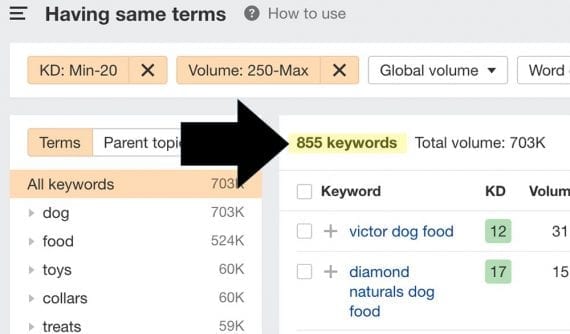
Filtering in Ahrefs dog-related keywords by search volume and difficulty narrows the list to 855 phrases.
Keyword Intent
Whether one has created a spreadsheet or used the filter feature in a keyword tool, it is now time to categorize by intent. Keyword intent identifies the goal of the searcher.
Not every search phrase is clear. But others signal obvious intent, such as:
- Navigational. Brand names or product names.
- Informational. These include words such as “how,” “why,” “what,” “help,” and “guide.”
- Investigational. Words such as “best,” “top,” “review,” and “price” typify this intent.
- Transactional. Here look for modifiers such as “buy,” “coupon,” “deals,” and similar.
Create Content
Finally, select the keyword phrases to create content around. Apply a simple question: Given a keyword phrase, can your business create an article that would benefit the reader and easily connect to one of your products?
via https://www.aiupnow.com
Armando Roggio, Khareem Sudlow
